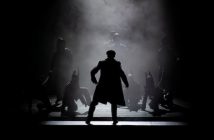You’d be forgiven for thinking that Romeo et Juliet, the recent production from Les Ballets de Monte Carlo to visit the London Coliseum, told the traditional story, but Jean-Christophe Maillot’s production is far from it. In fact, the only thing that remains fairly untouched is Sergei Prokifiev’s score. We’re all familiar with the romantic star crossed lovers of Shakespeare’s invention, but Maillot has directed the play from an entirely new angle.
The ballet is created around the perspective of Friar Laurence, the catalyst responsible for the inevitable fate of the star-crossed lovers. Told through flashbacks, his story recounts the tragedy. It is from this new perspective that we gain a different view of the story; that Romeo and Juliet was an accidental tragedy, not an honour-bound war between two families.
The ballet begins with Friar Lawrence, played by Alexis Oliviera, and his two friends entering a stark set. A minimalist vision of white walls deigned by Ernest Pignon-Ernest leaves much to the imagination. The slightly tortured pas de trois which ensues symbolises the Friar’s struggle between two worlds – that of the Capulets and the Montagues.
However, the Capulets and the Montagues are not the hate-fuelled families we know well. Maillot’s choreography portrays them as troublesome sixteen-year-olds, taunting and jeering at each other, with no real intention of causing any serious harm.
Juliet, played by Anja Behrend, is unkempt, passionate and wild. Romeo, played by Stephan Bourgond is reckless and laddish. And it appears that the emphasis of this production is not as much about perfect dancing as it is raw emotion. Indeed, Maillot’s choreography breaks many of the rules of traditional ballet, bringing in influences from modern dance and film to heighten the drama.
Mercutio’s death scene, for example, is very en vogue. As the action reaches a crescendo, the entire cast fall into slow motion, letting us absorb the chaos and intense range of emotions resulting from Mercutio’s death. Friar Lawrence’s flashbacks are particularly cinematic, allowing us to examine moments minutely.
But it’s not all passion and drama. The choreography also takes into account the humorous side of Verona life. Juliet’s Nurse, Gaëlle Riou brings a light-hearted take to the performance, with comedic attempts to calm the energetic Juliet and falling asleep while she’s meant to be working. Other touches of comedy feature Romeo joining Mercutio and Benvolio for a charming Punch and Judy-esque street performance, and they spend much time play-fighting each other.
There is one more surprising facet to this cornucopia of emotion. The tactile choreography breeds an innate sexiness, reminding us of the world of surging, uncontrollable teenage hormones.
This whole sensual effect is lifted by Jerome Kaplan’s costumes – floating metallic dresses and kimonos for the women and stark monochromatic costumes for the men. The costumes do little to stand out from the harsh white backdrop of minimalist Verona. So it is down to the movement of the dancers to work the fabric.
The Spartan look and feel extends itself right down to the props. Apart from the puppets, there is not much to focus on except our imaginations. No vial of poison, no elaborate balcony or four-poster bed. Instead, the choreography rather creatively uses Oliviera’s set to inspire our imaginations. Romeo’s death for example is truly inspired as he flings himself on the corner of Juliet’s tombstone, piercing his heart.
This is not going to be everyone’s ballet. But to those who might appreciate a different take on a traditional story, who can recognise the creative vision of this bold choreographer, it’s definitely a performance that will challenge your perception of a well-known tragedy.
Les Ballets de Monte-Carlo on tour at the London Coliseum. For future productions and booking information visit the website.




